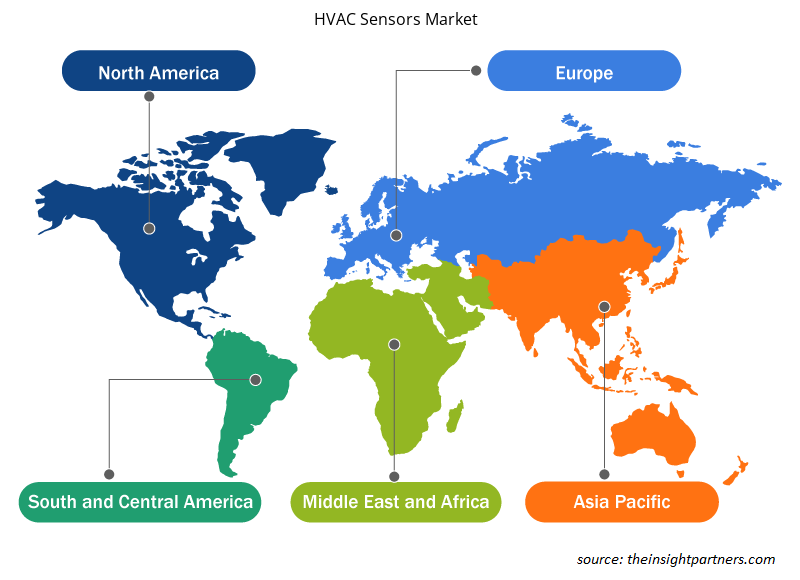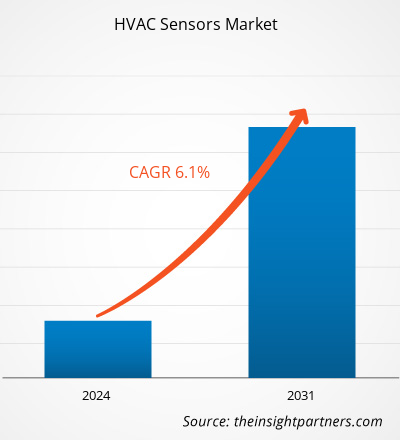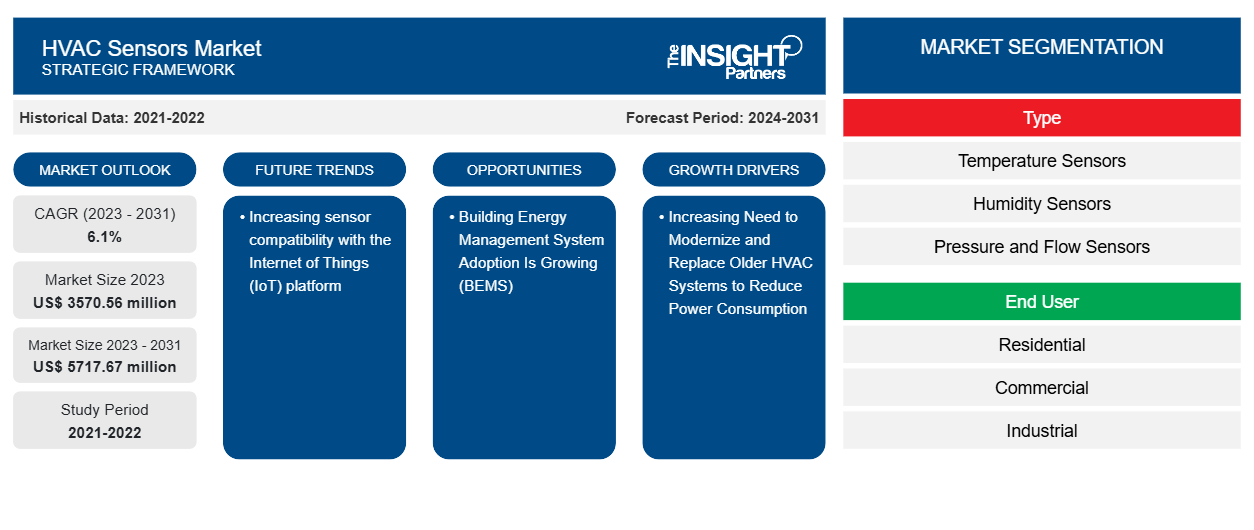Si prevede che la dimensione del mercato dei sensori HVAC raggiungerà i 5717,67 milioni di dollari entro il 2031, rispetto ai 3570,56 milioni di dollari del 2023. Si prevede che il mercato registrerà un CAGR del 6,1% nel 2023-2031.
È probabile che la crescente compatibilità dei sensori con la piattaforma Internet of Things ( IoT ) rimanga una tendenza chiave del mercato dei sensori HVAC .
Analisi di mercato dei sensori HVAC
Il mercato dei sensori HVAC è stato utilizzato da diversi settori, come quello commerciale, residenziale, automobilistico e altri. Oggigiorno, c'è una forte concorrenza nel mondo degli affari perché le organizzazioni leader devono dare priorità alla salvaguardia ambientale, alla produttività, alla qualità, alla sicurezza e alla protezione. Negli ultimi anni, i sistemi HVAC sono stati ampiamente utilizzati in molti programmi in tutto il mondo. Numerosi sensori, tra cui sensori di pressione e temperatura, tra gli altri, trovano un utilizzo che li rende possibili. I sistemi HVAC forniscono una buona qualità dell'aria e comfort termico sia per gli interni delle auto che per quelli delle stanze. I sensori HVAC sono utilizzati per soddisfare le esigenze di vari utenti finali che sono preoccupati per l'efficienza energetica. Aiutano a fornire spazi interni adeguatamente mantenuti con un basso consumo energetico.
Panoramica del mercato dei sensori HVAC
I sistemi HVAC sono spesso utilizzati per mantenere, controllare e quindi ridurre il consumo di energia. Un dispositivo audio che imita una condizione reale, come la temperatura o il mondo di destinazione, è incluso nella frequenza. Il tipo più significativo di sensore HVAC aiuta a mantenere la temperatura corretta e a modificare la temperatura necessaria differenziando la temperatura di ingresso dalla temperatura dell'edificio o della stanza. Per gli utenti finali, inclusi edifici industriali, residenziali e commerciali , i sensori HVAC possono gestire, controllare e monitorare varie operazioni come pressione dell'aria, temperatura e qualità. Di conseguenza, i sensori HVAC stanno diventando sempre più comuni a causa della necessità di risparmiare energia.
Personalizza questo report in base alle tue esigenze
Riceverai la personalizzazione gratuita di qualsiasi report, comprese parti di questo report, o analisi a livello nazionale, pacchetto dati Excel, oltre a usufruire di grandi offerte e sconti per start-up e università
-
Scopri le principali tendenze di mercato in questo rapporto.Questo campione GRATUITO includerà analisi di dati che spaziano dalle tendenze di mercato alle stime e alle previsioni.
Driver e opportunità di mercato dei sensori HVAC
Crescente necessità di modernizzare e sostituire i vecchi sistemi HVAC per ridurre il consumo energetico
Il World Economic Forum stima che gli edifici siano responsabili di oltre il 40% delle emissioni di anidride carbonica legate all'energia e di quasi un terzo del consumo energetico globale. Circa un terzo di queste emissioni, secondo il World Green Building Council, è causato dall'energia necessaria per le operazioni di un edificio, che includono riscaldamento, raffreddamento e alimentazione della struttura. Secondo Iota Communications, un edificio per uffici medio spende circa $ 30.000 all'anno in elettricità. In una struttura commerciale, i sistemi HVAC consumano spesso più energia. Secondo le stime del Dipartimento dell'energia degli Stati Uniti , i sistemi HVAC normalmente rappresentano il 35% del consumo energetico di un edificio. La necessità di sistemi HVAC con caratteristiche di filtraggio dell'aria è aumentata durante la pandemia. I sistemi di ventilazione aggiornati svolgono uno scopo cruciale per la salute pubblica filtrando l'aria e riducendo gli inquinanti atmosferici, come le particelle contenenti virus.
L'adozione del sistema di gestione dell'energia degli edifici è in crescita ( BEMS )
Gli edifici non possono funzionare senza sistemi HVAC nonostante la loro spesa esorbitante. Il Dipartimento australiano per i cambiamenti climatici, l'energia, l'ambiente e l'acqua stima che il sistema HVAC medio utilizzi circa il 40% del consumo energetico complessivo dell'edificio e il 70% del suo consumo energetico di base. I sistemi automatizzati basati su computer noti come Building Energy Management Systems ( BEMS ) tengono d'occhio e regolano ogni sistema correlato all'energia negli edifici, comprese le apparecchiature meccaniche ed elettriche. Abilitando un controllo preciso e automatizzato dei sistemi energetici e della fornitura, la gestione energetica protegge le aziende da inutili spese energetiche. Un'azienda può ridurre il suo attuale consumo energetico fino al 10% - 30% con l'ausilio di BEMS , afferma Radiocrafts . A causa del conflitto tra Russia e Ucraina, i prezzi dell'energia stanno salendo alle stelle nell'UE. Pertanto, si prevede che l'adozione del sistema di gestione energetica degli edifici ( BEMS ) presenterà nuove opportunità per gli operatori HVAC durante il periodo di previsione.
Analisi della segmentazione del report HVAC
I segmenti chiave che hanno contribuito alla derivazione dell'analisi HVAC sono la tipologia e gli utenti finali.
- In base al tipo, l'HVAC è segmentato in sensori di temperatura, sensori di umidità, sensori di pressione e flusso, sensori di movimento, sensori di fumo e gas e altri. Il segmento dei sensori di temperatura ha detenuto una quota di mercato maggiore nel 2023.
In base all'utente finale, il mercato dei sensori HVAC è segmentato in residenziale, commerciale e industriale.
Analisi della quota di mercato dei sensori HVAC per area geografica
L'ambito geografico del rapporto di mercato sui sensori HVAC è suddiviso principalmente in cinque regioni: Nord America, Asia Pacifico, Europa, Medio Oriente e Africa e Sud America/Sud e Centro America. Grazie a un numero enorme di infrastrutture contemporanee e ben sviluppate, tra cui edifici commerciali, strutture industriali e proprietà residenziali, il Nord America ha la quota di mercato maggiore per sensori e controller HVAC. Esiste un mercato considerevole per sensori e controller HVAC a causa dell'abbondanza di edifici con sistemi HVAC complessi.
Approfondimenti regionali sul mercato dei sensori HVAC
Le tendenze regionali e i fattori che influenzano il mercato dei sensori HVAC durante il periodo di previsione sono stati ampiamente spiegati dagli analisti di Insight Partners. Questa sezione discute anche i segmenti e la geografia del mercato dei sensori HVAC in Nord America, Europa, Asia Pacifico, Medio Oriente e Africa e America meridionale e centrale.

- Ottieni i dati specifici regionali per il mercato dei sensori HVAC
Ambito del rapporto di mercato sui sensori HVAC
| Attributo del report | Dettagli |
|---|---|
| Dimensioni del mercato nel 2023 | 3570,56 milioni di dollari USA |
| Dimensioni del mercato entro il 2031 | 5717,67 milioni di dollari USA |
| CAGR globale (2023-2031) | 6,1% |
| Dati storici | 2021-2022 |
| Periodo di previsione | 2024-2031 |
| Segmenti coperti |
Per tipo
|
| Regioni e Paesi coperti |
America del Nord
|
| Leader di mercato e profili aziendali chiave |
|
Densità dei player del mercato dei sensori HVAC: comprendere il suo impatto sulle dinamiche aziendali
Il mercato dei sensori HVAC sta crescendo rapidamente, spinto dalla crescente domanda degli utenti finali dovuta a fattori quali l'evoluzione delle preferenze dei consumatori, i progressi tecnologici e una maggiore consapevolezza dei vantaggi del prodotto. Con l'aumento della domanda, le aziende stanno ampliando le loro offerte, innovando per soddisfare le esigenze dei consumatori e capitalizzando sulle tendenze emergenti, il che alimenta ulteriormente la crescita del mercato.
La densità degli operatori di mercato si riferisce alla distribuzione di aziende o società che operano in un particolare mercato o settore. Indica quanti concorrenti (operatori di mercato) sono presenti in un dato spazio di mercato in relazione alle sue dimensioni o al valore di mercato totale.
Le principali aziende che operano nel mercato dei sensori HVAC sono:
- Siemens AG
- Azienda Emerson Electric
- Honeywell International Inc.
- Johnson Controls, Inc.
- Schneider elettrico
- Società per azioni TE Connectivity Ltd.
Disclaimer : le aziende elencate sopra non sono classificate secondo un ordine particolare.

- Ottieni una panoramica dei principali attori del mercato dei sensori HVAC
Notizie di mercato e sviluppi recenti sui sensori HVAC
Il mercato dei sensori HVAC viene valutato raccogliendo dati qualitativi e quantitativi dopo la ricerca primaria e secondaria, che include importanti pubblicazioni aziendali, dati associativi e database. Di seguito è riportato un elenco degli sviluppi nel mercato dei disturbi del linguaggio e della parola e delle strategie:
- Nell'ottobre 2023, Sensata Technologies ha annunciato il lancio del sensore Sensata Resonix RGD, il primo sensore di rilevamento perdite con certificazione UL per più gas refrigeranti A2L utilizzati nelle apparecchiature di riscaldamento, ventilazione e condizionamento dell'aria (HVAC). I nuovi sensori di rilevamento perdite supportano la transizione dei produttori HVAC verso refrigeranti con un impatto inferiore sul riscaldamento globale. (Fonte: Sensata Technologies, comunicato stampa)
- A gennaio 2023, Third Reality ha lanciato un sensore di temperatura e umidità. (Fonte: Third Reality, comunicato stampa)
Copertura e risultati del rapporto di mercato sui sensori HVAC
Il rapporto "Dimensioni e previsioni del mercato dei sensori HVAC (2021-2031)" fornisce un'analisi dettagliata del mercato che copre le seguenti aree:
- Dimensioni e previsioni del mercato a livello globale, regionale e nazionale per tutti i segmenti di mercato chiave coperti dall'ambito
- Dinamiche di mercato come fattori trainanti, vincoli e opportunità chiave
- Principali tendenze future
- Analisi dettagliata delle cinque forze PEST/Porter e SWOT
- Analisi di mercato globale e regionale che copre le principali tendenze di mercato, i principali attori, le normative e gli sviluppi recenti del mercato
- Analisi del panorama industriale e della concorrenza che copre la concentrazione del mercato, l'analisi della mappa di calore, i principali attori e gli sviluppi recenti
- Profili aziendali dettagliati
- Analisi storica (2 anni), anno base, previsione (7 anni) con CAGR
- Analisi PEST e SWOT
- Valore/volume delle dimensioni del mercato - Globale, Regionale, Nazionale
- Industria e panorama competitivo
- Set di dati Excel
Report recenti
Rapporti correlati
Testimonianze
Motivo dell'acquisto
- Processo decisionale informato
- Comprensione delle dinamiche di mercato
- Analisi competitiva
- Analisi dei clienti
- Previsioni di mercato
- Mitigazione del rischio
- Pianificazione strategica
- Giustificazione degli investimenti
- Identificazione dei mercati emergenti
- Miglioramento delle strategie di marketing
- Aumento dell'efficienza operativa
- Allineamento alle tendenze normative























 Ottieni un campione gratuito per - Mercato dei sensori HVAC
Ottieni un campione gratuito per - Mercato dei sensori HVAC